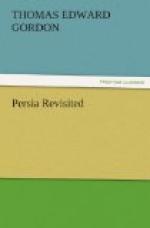As neither law nor custom forbids the manufacture of wine by non-Mohammedans, the cultivation of the grape spreads, and the making of wine increases. From this it may be inferred, as there is little export of wine from Persia, that all the produce is not consumed by non-Mohammedans. As a matter of fact, the religious law which forbids wine to Mohammedans is not rigidly observed; in truth, they are not all total abstainers, and the delightful poison, as chronicled by Moulla Akbar, is known to be a convenient remedy for all manner of moods, ills, and complaints, nervous, imaginary, and real. They have been described as drinking well when they do break the religious law, for they have a saying that ‘there is as much sin in a glass as in a flagon.’ The Persians have never thoroughly accommodated themselves to the creed of their Semitic conquerors; they show profound respect for the externals of Mohammedanism, and are sincere in their practice of piety and the obligations of religion and charity; but they have always indulged in the fancies and ideas of the great school of free-thinking philosopher Sofis, whose observance of the ordinances of severe and joyless life is notedly lax.
The weather was lovely as we journeyed over the Kasvin plain to Tehran, towards the end of September. Autumn in the North of Persia is a gloriously fine season, almost spring-like in many ways, and, indeed, it is called there the ‘second spring.’ The landscape then, though nearly barren of verdure, has a beauty of its own in warm soft colours, and the atmospheric effects on the hills and distances, evening and morning, are of wonderfully delicate tones and tints. The prominent feature in the landscape near Tehran is the grand cone-shaped Mount Demavend, about forty miles to the north-east, which shoots up 19,400 feet above ocean-level, and overtops all the surrounding heights by 6,000 feet or more. It stood out bold, cold, and clear against the blue sky, and looked beautifully white with a fresh covering of new snow, and it was more than usually distinct, from being clear of the cloud-crown it usually wears. In the evening the massive peak presented a splendid appearance, looking as in a white heat from the shine of the setting sun, which, though lost to view below the horizon, yet lighted up the old volcano.
Demavend has long been asleep, but the great earthquakes of 1891, 1893 and 1895 in Astrabad and Kuchan to the eastward, and Khalkhal in the north-west, show that its underground fires are still alight. The scene of the last is about one hundred miles north-east of the old volcanic region of Afshar, remarkable for its remains of vast ‘cinter’ cones, formed by the flowing geysers of long, long ago, and which were shattered and scattered by some mighty explosion, when the great geysers boiled up and burst their walls. Here is seen the Takht-i-Suliman, a ruined fort of very ancient date, which local tradition describes as one of King Solomon’s royal residences, shared




